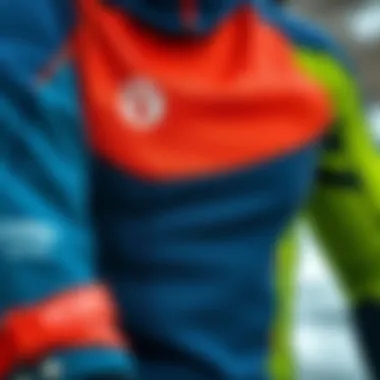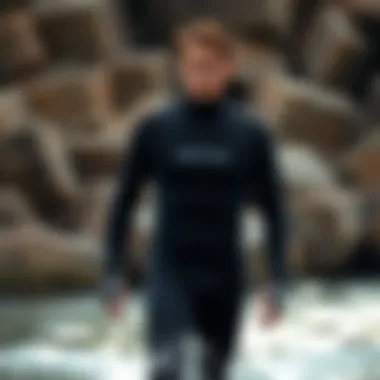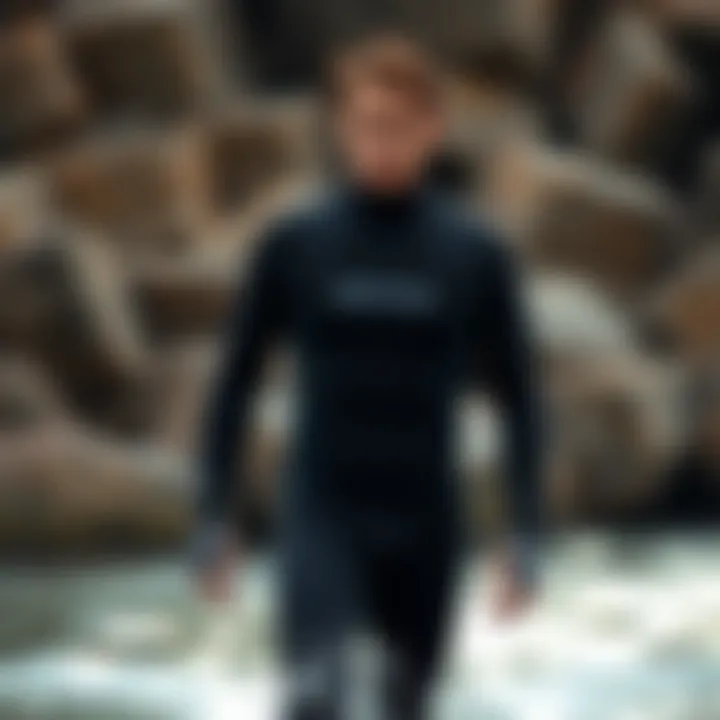Wetsuit Jacket Sale: Essential Insights for Buyers


Intro
Wetsuit jackets have become a cornerstone for anyone engaged in water sports, providing not only warmth but also a level of protection that can be crucial in various conditions. Whether you're catching waves on a surfboard, gliding across the water on a paddleboard, or navigating the breezy skies while kitesurfing, these jackets are tailored to enhance your experience. As the market sees a surge in options, determining which wetsuit jacket best meets your needs can feel like looking for a needle in a haystack. This guide aims to unpack the critical elements surrounding wetsuit jackets, shedding light on their features, materials, and significance in different water adventures.
Purchasing a wetsuit jacket is not just about jumping on a sale; it’s essential to understand your choices. With insights into durability, functionality, and the cost-effectiveness of high-quality options, you'll be better equipped to invest wisely. Additionally, we’ll also dive into the most current deals from reputable brands, assisting you in making enlightened decisions that combine performance and price. The key features and upkeep necessities of these jackets will round off your understanding, ensuring prolonged use and satisfaction in your watersport pursuits.
Let’s kick things off by discussing the essentials of gear.
Understanding Wetsuit Jackets
Wetsuit jackets are more than just an accessory for water sports enthusiasts; they play a pivotal role in maintaining comfort and performance in various aquatic environments. From surfing and paddleboarding to kitesurfing and diving, one cannot overlook the advantages provided by these jackets. Understanding their purpose, types, and materials puts the consumer in a position to make a more informed decision, especially when sales abound.
Purpose of Wetsuit Jackets
The primary function of a wetsuit jacket is to offer thermal protection. These jackets allow a water sports lover to enjoy longer sessions outdoors without suffering from the chill that can set in after prolonged exposure to water. Not only do they keep you warm, but they also serve as a protective layer against abrasions from surfboards, rocks, and other sharp objects you may encounter in marine environments.
Moreover, wetsuit jackets are designed to enhance your performance. They can reduce drag while paddling or surfing on a wave, giving you that little edge that can transform a good ride into a great one. The right jacket can help maintain body temperature, aiding endurance and allowing the wearer to focus more on technique rather than fighting against the elements.
Types of Wetsuit Jackets
Shorty Jackets
When talking about shorty jackets, one can't help but recognize their appeal among various water sports users. These jackets typically feature short sleeves and legs, allowing for maximum flexibility while also providing enough warmth for milder water temperatures. The key characteristic of shorty jackets is their versatility. They're a popular choice during warmer months or in regions where water temperatures are generally cool but can still be comfortable.
One of the unique features of shorty jackets is their construction, which often incorporates thinner neoprene, making them lighter. This means that while they provide some thermal protection, they also allow for easy movement and greater mobility. However, the trade-off is that they may not deliver sufficient warmth for colder conditions.
Full-Body Jackets
In contrast, full-body jackets provide comprehensive coverage and are designed for more frigid waters. The key aspect here is insulation. With long sleeves and legs, they cover much more of the body, ensuring that heat loss is minimized even when you are in colder environments for extended periods of time. This makes them a favorite among serious surfers and divers who often contend with low temperatures.
A notable feature of full-body jackets is their thickness, typically around 3mm to 5mm of neoprene, which adds buoyancy and warmth. Yet, the downside can be a restriction in movement compared to shorty types, which could impact performance for highly dynamic sports.
Hybrid Designs
Hybrid designs combine elements of both shorty and full-body jackets, which opens up a range of functionality. For instance, these jackets might have long sleeves while incorporating short legs or vice versa, catering to specific needs based on climate and water temperature. Their versatility is quite advantageous for puddling surfers and kitesurfers often faced with changing conditions.
Part of what makes hybrid designs appealing is their adaptability. They can be used in a variety of settings, from warmer waters to those that are just a touch chilly. The downside, however, could be the balance of insulation versus flexibility that may not meet all surfers' expectations.
Materials Used in Construction
Neoprene Variants
The core material used in nearly all wetsuit jackets is neoprene. Variants of this material have evolved over time, significantly impacting the insulation, comfort, and flexibility of the jackets. Commonly found variations include super-stretch neoprene and limestone neoprene, both designed to enhance mobility while ensuring warmth.
These neoprene variants are beneficial because they provide excellent insulation properties, allowing water to stay relatively warm between the jacket and the user's skin. However, they can be quite sensitive to wear and tear, necessitating proper care to extend their lifespan.
Thermal Linings
Designed to further enhance warmth, thermal linings often line the interior of wetsuit jackets. This feature adds a layer of comfort and is particularly useful for cold water conditions. The key characteristic of these thermal linings is their ability to trap body heat whilst still allowing for moisture management. Such linings can significantly improve warmth retention, making them a sought-after aspect.
Despite their benefit, thermal linings can add weight to the jacket, which may not appeal to everyone. Some may find this extra bulkiness to be cumbersome during more vigorous activities.


Eco-friendly Options
In a world increasingly aware of the environment, eco-friendly options for wetsuit jackets have emerged. These variants are made from sustainable materials, reducing the ecological footprint of these essential water sports gear. The key characteristic here is the use of plant-based neoprene or recycled materials, which offer decent insulation while being less harmful to the planet.
While these eco-friendly options should be celebrated for their environmental impact, they may not always deliver the same level of performance as traditional wetsuit materials. Nevertheless, for eco-conscious consumers, these options present an intriguing balance between performance and sustainability.
In summary, understanding wetsuit jackets entails more than just knowing what they are made of. By diving into their purposes, types, and materials, you lay a solid foundation for making an informed choice, especially when sales and discounts come into play.
Key Features to Consider
When diving into the world of wetsuits, especially jackets, one must pay close attention to the various features that play a pivotal role in performance and comfort. It's not just about keeping warm; it’s about ensuring you get the best possible experience while surfing, paddleboarding, or kitesurfing. In this section, we'll explore essential components such as insulation, flexibility, stretch, and the critical nature of seam construction.
Insulation and Thermal Protection
A core characteristic of any wetsuit jacket is its ability to provide insulation and thermal protection. These jackets are designed to trap a thin layer of water between the skin and the suit, which then gradually warms up to body temperature. This concept is crucial for maintaining heat, especially during those chilly morning surf sessions or extended time out on a paddleboard. There are different insulation levels to consider, often indicated by the thickness of the neoprene used in construction.
Weights of 2mm, 3mm, or even 5mm can vary significantly in terms of warmth and give you options based on the waters you’re venturing into. For instance, thick neoprene is fantastic for colder climates, ensuring you don’t catch a chill midway through a session. Just be mindful, though, as too much insulation can hinder mobility—finding a balance is key.
Flexibility and Stretch
Flexibility is another non-negotiable feature when selecting a wetsuit jacket. A jacket that fits snug without being restrictive can enhance your performance, whether you’re catching waves or riding the wind. Neoprene itself comes in various compositions that can offer more stretch, allowing freedom of movement. You want to look for materials that provide excellent flexibility, making it easier to paddle or perform tricks without feeling stiff.
Often, wetsuit jackets boast an “Ultra-Stretch” designation, referring to how much the material can expand and contract. Keep an eye out for features like this, as they significantly influence overall comfort and agility in the water.
Seam Construction
The seam construction in wetsuit jackets cannot be overlooked. It's the difference between staying warm and dry versus feeling like you dove into a pool every time you hit the water. There are two primary types of seams to consider:
Flatlock vs. Blind Stitch
Flatlock seams are the most common and recognizable type used in wetsuit manufacturing. They are sewn together with overlapping pieces of neoprene and then stitched flat, which makes them comfortable and less likely to create pressure points. However, one downside is that they can be less watertight. So, if you’re the type who dreads that chilling trickle of water sneaking in, keep this in mind.
On the other hand, the blind stitch technique, which involves only partially stitching the neoprene together, creates a tighter seal and offers better insulation due to its reduced water entry points. While this method can be more labor-intensive and typically leads to a higher price point, many serious surfers and water sports enthusiasts find it a worthwhile investment.
Taped Seams
Taped seams are similar to blind stitches in design but take it a step further by applying a thin layer of tape to the seam on the inside. This method enhances the suit’s waterproof capabilities and adds durability, making it an excellent choice for those who frequently face harsh conditions. Taped seams can be a bit pricier, generally creating a more robust and versatile wetsuit jacket, but they offer that added peace of mind.
The Importance of Fit
Getting the right fit for your wetsuit jacket is akin to finding the perfect running shoes; it makes all the difference between a good day on the water and a frustrating experience that leaves you shivering. When it comes to specialized gear like a wetsuit, a suitable fit isn't just about comfort; it can significantly affect your overall performance and enjoyment. In watersports, where every second counts, having a jacket that seamlessly hugs your body without being restrictive can enhance your agility and keep water from seeping in. A well-fitting wetsuit jacket is your ally against fluctuating water temperatures and unexpected elements.
Finding Your Size
Finding the right size for your wetsuit jacket requires a little more than just pulling out your usual shirt size. Wetsuits operate on a unique sizing scale, so it's essential to take actual body measurements. Start by measuring your chest, waist, and hips. Many brands offer sizing charts that correlate these measurements with their size categories, making it easier to decide. While you might be used to a small in everyday wear, wetsuits often fit snugly, with size recommendations leaning toward medium or large. Each brand has its quirks, so don’t skimp on this crucial step.
To ensure you grab the right fit, here’s a quick guide:
- Chest Measurement: Measure around the fullest part of your chest.
- Waist Measurement: Take your waist measurement at its narrowest point.
- Hip Measurement: Measure around the widest part of your hips.
With these numbers in hand, consult the manufacturer’s sizing chart. This not only helps choose the proper size but can provide insights on whether the jacket will accommodate your specific body shape. Remember, fit preferences may vary based on personal comfort as well, so don't hesitate to try a couple of options if possible.


Effect of Fit on Performance
A snug fit is crucial for optimal thermal regulation and buoyancy. When your wetsuit jacket fits well, it creates a barrier against cold water and reduces drag as you slice through waves. Conversely, if it’s too loose, you may find that water flows in and out of the jacket, cooling you far too quickly which can hinder not only your comfort but also your performance. Think about it—when you're focused on adjusting your jacket instead of catching the perfect wave, you're more likely to miss out on the fun.
Moreover, your range of motion is vastly impacted by fit. A jacket that offers the right balance of tightness and flexibility allows you to paddle, dive, and maneuver more easily without feeling like you’re confined in a straightjacket.
Here’s a quick rundown of how fit affects performance:
- Buoyancy: A tailored fit provides better buoyancy by keeping air trapped closer to the body.
- Thermal Efficiency: The closer the fit to your skin, the better insulation and warmth you maintain.
- Mobility: An unrestricted fit enhances your ability to move freely, whether you're paddling, surfing, or kiteboarding.
Current Market Trends
When it comes to purchasing a wetsuit jacket, the current market trends play a pivotal role in guiding consumers toward making well-informed choices. With an ever-evolving landscape of manufacturers, materials, and cut-throat competition, keeping an eye on these trends will help shoppers find the ideal jackets that suit their water activities and personal style.
Brand Comparisons
Top Manufacturers
The top manufacturers of wetsuit jackets, like O'Neill and Rip Curl, demonstrate a commitment to quality and technology that has helped carve out their respected positions in the market. These brands are known for incorporating advanced materials and innovative designs, which directly contribute to performance and durability. For instance, the use of super-stretch neoprene by O'Neill allows for unparalleled flexibility, greatly enhancing comfort and ease of movement in the water.
Their products often come equipped with features like liquid-sealed seams, which minimize water entry and enhance insulation, making them particularly desirable for colder conditions. In a competitive market, consumers are often drawn to these tried-and-true options due to their well-established reputations for quality and reliability. However, top-tier brands often come with higher price tags, which can be a limiting factor for some buyers.
Emerging Brands
On the flip side, emerging brands such as Imagine Surf and Roxy are shaking up the peaceful waters occupied by the big giants. These companies typically focus on niche markets and are known for their innovative approaches, like eco-conscious materials and unique designs that appeal to a younger demographic. Imagine Surf has garnered attention for its use of recycled materials in the construction of their jackets, addressing growing environmental concerns within the outdoor apparel industry.
For many, this focus on sustainability is a game-changer, allowing conscious consumers to make purchases that align with their values while still enjoying high-quality performance. However, as these brands are newer, they sometimes lack the extensive testing and user feedback that come with established names.
Sales Overview
As the sport gets traction worldwide, the sales dynamics for wetsuit jackets reflect varying consumer behaviors. Seasonal patterns often dictate when to snag a good deal. The majority of significant sales events occur during the off-season, particularly in the fall and spring. This is the perfect time to look for performance jackets, as brands aim to clear out inventory to make way for new designs.
"The best time to buy a wetsuit jacket is when the sales start rolling in during the offseason, as retailers tend to offer significant discounts to attract customers."
Additionally, keeping an eye on promotions like Black Friday or Cyber Monday will also enhance chances of finding quality jackets at reduced prices. Given the competitive landscape, shoppers must be strategic about when they purchase. By doing so, they can not only save money but also possibly invest in higher-quality gear that might be out of their budget during peak times.
Understanding Sales and Discounts
When it comes to purchasing wetsuit jackets, understanding sales and discounts can be the difference between a wise investment and an unnecessary expenditure. With a plethora of brands in the market, the competition often leads to attractive deals, especially when the season changes or new models are released. From surfers seeking to ride the perfect wave to paddleboarders wanting to stay warm while enjoying serene lake views, knowing when and where to find these sales provides not just savings, but also assurance in quality.
When to Buy
Timing is everything. The wetsuit industry often gears up for seasonal sales tied to major events or changing climates. The best times to buy typically include:
- End of the summer: As water sports wind down and shop inventories start to clear, many retailers offer significant markdowns.
- Holiday sales: Events like Black Friday, Cyber Monday, and even Memorial Day offer countless discounts on outdoor gear, including wetsuits.
- Spring: Many manufacturers showcase their new models in spring; this often leads to a clearance of older stock at lower prices.
Being savvy about these trends can help you snag that high-quality wetsuit jacket without offloading your entire budget.
What to Look for in a Sale
When checking out sales, it's crucial to know what is truly a deal versus what is simply marked down for the sake of sales. Here are some elements to consider:


- Discount Percentage: Look for significant discounts; items marked down below 30% may not be enough to justify a buy, especially for high-end gear. Aim for 40% or more where possible.
- Quality over Price: Sometimes, a high discount might signal a poor-quality product. Always verify the brand’s reputation and customer reviews.
- Return Policy: Sales can come with different return policies. Ensure the store allows returns or exchanges, which can save you from buyer’s remorse if the product doesn’t meet expectations.
Keeping an eye out for these criteria ensures that shoppers not only save money but also secure a wetsuit jacket that meets their performance needs.
Comparative Analysis of Discounts
Understanding discounts across different retailers can shed light on the real value of your potential purchase. Not all sales are created equal, and here’s how to navigate:
- Online vs. In-Store Sales: Online retailers often provide better discounts due to lower overhead costs. However, in-store sales provide the advantage of trying on products beforehand.
- Brand Specific Sales: Some brands such as O'Neill or Rip Curl might offer better discounts during specific times due to stock management strategies. Research brand loyalty programs that might provide additional savings or exclusive offers.
- Seasonality Effects: Prices can fluctuate based on season; for example, wetsuits may be cheaper in warmer months when demand is typically lower. Keep track of trends to anticipate the best times for purchases.
Understanding these patterns helps inform your decisions and makes certain you’re not just shopping in the dark.
"Knowledge of timing and product quality makes all the difference in achieving a worthwhile wetsuit purchase."
In summary, navigating the world of wetsuit jacket sales requires a keen eye. Be mindful of timing your purchase around clearances, knowing what a good deal is, and comparing offers across vendors. This will not just optimize your savings, but also enhance your watersport experience.
Maintenance and Care for Wetsuit Jackets
Proper maintenance and care of wetsuit jackets can extend their lifespan significantly. Whether you're a casual surfer, a passionate kitesurfer, or instructing the next generation of paddlers, ensuring that your gear remains in top condition can prevent costly replacements. A well-cared wetsuit not only performs better, but also provides an essential layer of warmth and protection.
Washing and Drying Techniques
Cleaning your wetsuit jacket is more than just tossing it in a washing machine. Here’s a straightforward approach to keep your gear in peak condition:
- Rinse Immediately: After each use, rinse your wetsuit with fresh water. This step is vital to remove salt, sand, and chlorine, which can degrade the material over time.
- Gentle Cleaning: Use a mild soap specifically designed for wetsuits, like those from brands like McNett or O'Neill. Avoid harsh detergents that could damage the neoprene.
- Cold Water Wash: If washing by hand, stick to cold water. Hot water can warp the suit's fit and affect its insulation properties.
- Air Dry: Never use a tumble dryer. Instead, hang your wetsuit jacket inside out on a wide hanger in a shaded area. Direct sunlight can loosen the material and cause fading. Turn it right-side out after a few hours for even drying.
By following these techniques, not only can users maintain the performance of their wetsuits, but also enhance longevity, saving money in the long run.
Storage Practices
Where and how you store your wetsuit jacket also plays an important role in its maintenance. Here are some best practices:
- Avoid Folding: Rather than folding, hang your wetsuit jacket on a sturdy hanger to prevent creases, which can weaken material over time.
- Choose a Cool, Dry Space: Store your wetsuit in a well-ventilated area that is free from humidity. A damp environment can create mildew, which is not only unpleasant but can also damage the suit.
- Out of Direct Sunlight: Prolonged exposure to UV rays can degrade the fabric; hence, opting for a dark space or inside a garment bag is better.
- Check Regularly: Inspect your wetsuit jacket periodically for signs of damage or wear, especially after a season of heavy use. Small tears can be repaired early on, preventing bigger issues later.
Taking proper care of your wetsuit jacket isn’t just about making it last longer; it’s about ensuring that you can enjoy your water sports without interruption. After all, who wants to cut short a thrilling session because of a faulty wetsuit? If you’re serious about your watersports, taking the time to care for your gear will pay off tenfold in performance and comfort.
Ending
In this journey through the world of wetsuit jackets, we have explored not only their significance in various watersports but also how to navigate the complex landscape of purchases and maintenance. The importance of making the right choice cannot be overstated, especially as a poorly chosen jacket can impact performance and comfort while on the water. As surfers, paddleboarders, kitesurfers, and instructors, knowing what fits best and what features to prioritize can transform your experience.
Making the Right Choice
Making an informed decision when selecting a wetsuit jacket requires careful consideration of several elements. Start with the intended water conditions; a shorty jacket may be perfect for warmer temperatures, while a full-body model might suit colder waters better. Additionally, it’s crucial to think about your activity level and specific needs. For instance, someone who frequently battles high waves may prioritize flexibility over insulation, seeking a more streamlined design.
Consider also the reputable brands known for quality and durability. Brands like O’Neill, Rip Curl, or Patagonia have developed strong followings for good reasons—reliability and consistent performance. Reading user reviews and performance tests can help you judge the longevity and effectiveness of a jacket before committing to a purchase. Remember, the price tag can sometimes reflect the quality, so it might be worth spending a bit more for a jacket that you can rely on.
Future Trends in Wetsuits
As we look ahead, the industry is continuously evolving. The latest trends focus on sustainability, innovation, and personalization. Many manufacturers are investing in eco-friendly materials, which not only appeal to an environmentally conscious consumer base but also offer functional benefits like enhanced insulation and flexibility. Neoprene alternatives made from Yulex and other plant-based materials are paving the way for a greener future in watersport gear.
Wearable technology is also becoming more prominent. Some wetsuit jackets now include sensors that can track your performance metrics like heart rate and body temperature, integrating directly with your smartphone. This can lead to a more customized and enjoyable experience.
"Understanding the changing landscape of wetsuit technology is essential for any serious water sports enthusiast."
Ultimately, keeping an eye on these trends not only allows you to enjoy the latest innovations but may also save you money long-term. As jackets improve in design and technology, you’ll find options that offer better performance, comfort, and longevity, making your time in the water even more enjoyable.
In summary, this article has guided you through the essentials needed to make an informed purchase when it comes to wetsuit jackets. The world of watersports is vivid and ever-changing, and so too are the tools to enhance your experience. As always, equipping yourself with knowledge pays off, leading to more enjoyable and fulfilling adventures.



